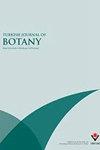Seed Morphology of some taxa of the genus Euphorbia L. (Euphorbiaceae) in Turkey and its taxonomic significance
IF 1.5
4区 生物学
Q3 PLANT SCIENCES
引用次数: 0
Abstract
: The morphological characteristics of seeds are not affected by environmental factors and can be used to identify the Euphorbia taxa. The present study aims to determine the morphological characteristics of seeds in 27 taxa of Euphorbia using scanning electron microscopy (SEM) and light microscope (LM). Findings revealed that the seeds of Euphorbia show variation in size, color, and seed surface ornamentations among different species. The seeds vary also in shape from ovoid, ellipsoidal, globose, quadrangular, compressed, to compressed-ellipsoidal with two exceptions in E. petiolata (oblong-quadrangular truncate), E. macrocarpa (subglobose), and E. szovitsii var. kharputensis (ellipsoidal quadrangular truncate). Furthermore, it was demonstrated that caruncle color, shape, and surface are different in the studied Euphorbia spp. Special attention was also paid to lipid granules indicating their shape variation among taxa from globose, broad ellipsoidal globose to reniform, although the granules were absent in some taxa. In addition, some taxa lack any caruncle. The unweighted pair group method with arithmetic mean and principal component analysis was used to assess the morphological differentiation of the seeds among the studied taxa. According to the dendrogram and plot obtained from cluster and PCA analyses, Euphorbia taxa are divided into four clusters corroborating the previous molecular phylogenetic results.土耳其大戟科大戟属部分分类群种子形态及其分类意义
:种子的形态特征不受环境因素的影响,可用于鉴定大戟属分类群。本研究旨在利用扫描电子显微镜(SEM)和光学显微镜(LM)测定大戟属27个分类群种子的形态特征。研究结果表明,不同物种的大戟种子在大小、颜色和种子表面装饰方面存在差异。种子的形状也各不相同,从卵球形、椭球形、球状、四边形、压扁到压扁的椭球形,只有两个例外,即小叶柄E.petiolata(长圆形四边形截形)、大果果E.macrocarpa(近球形)和狭叶E.szovitsii var.karputensis(椭球形四边形截形)。此外,研究表明,在所研究的大戟属植物中,浆果的颜色、形状和表面是不同的。还特别注意脂质颗粒,表明它们在从球形、宽椭球球形到肾形的分类群中的形状变化,尽管在一些分类群中没有颗粒。此外,一些分类群没有任何车壳。采用算术平均和主成分分析相结合的未加权配对群方法来评估所研究分类群之间种子的形态分化。根据聚类分析和主成分分析获得的树状图和图谱,大戟分类群被分为四个聚类,证实了先前的分子系统发育结果。
本文章由计算机程序翻译,如有差异,请以英文原文为准。
求助全文
约1分钟内获得全文
求助全文
来源期刊

Turkish Journal of Botany
PLANT SCIENCES-
CiteScore
2.90
自引率
5.60%
发文量
31
审稿时长
6-12 weeks
期刊介绍:
The Turkish Journal of Botany is published electronically 6 times a year by the Scientific and Technological Research Council of Turkey (TÜBİTAK) and accepts manuscripts (in English) covering all areas of plant biology (including genetics, evolution, systematics, structure, function, development, diversity, conservation biology, biogeography, paleobotany, ontogeny, functional morphology, ecology, reproductive biology, and pollination biology), all levels of organisation (molecular to ecosystem), and all plant groups and allied organisms (algae, fungi, and lichens). Authors are required to frame their research questions and discuss their results in terms of major questions in plant biology. In general, papers that are too narrowly focused, purely descriptive, or broad surveys, or that contain only preliminary data or natural history, will not be considered (*).
The following types of article will be considered:
1. Research articles: Original research in various fields of botany will be evaluated as research articles.
2. Research notes: These include articles such as preliminary notes on a study or manuscripts on the morphological, anatomical, cytological, physiological, biochemical, and other properties of plant, algae, lichen and fungi species.
3. Reviews: Reviews of recent developments, improvements, discoveries, and ideas in various fields of botany.
4. Letters to the editor: These include opinions, comments relating to the publishing policy of the Turkish Journal of Botany, news, and suggestions. Letters should not exceed one journal page.
(*) 1. Raw floristic lists (of algae, lichens, fungi, or plants), species descriptions, chorological studies, and plant sociology studies without any additional independent approaches.
2. Comparative morphology and anatomy studies (that do not cover a family, tribe, subtribe, genus, subgenus, section, subsection, or species complexes with taxonomical problems) without one or more independent additional approaches such as phylogenetical, micromorphological, chromosomal and anatomical analyses.
3. Revisions of family, tribe, genus, subgenus, section, subsection, or species complexes without any original outputs such as taxonomical status changes, IUCN categories, and phenological and ecological analyses.
4. New taxa of all plants without any additional independent approaches such as phylogenetical, ecological, chromosomal, chorological and correlational analyses in addition to a detailed macro- and micro-morphological descriptions with quality field and microscopic illustrations of taxonomically important structures and identification key in the taxonomic group.
New records of all plants without any additional independent approaches such as phylogenetical, ecological, chromosomal, chorological and correlational analyses in addition to a detailed macro- and micro-morphological descriptions with quality field and microscopic illustrations of taxonomically important structures and identification key in the taxonomic group may be accepted for peer review if they contain 3 or more new records or taxonomical status update, such as lectotypification, new combinations, transfers, revivals and synonyms.
5. New taxa of algae, lichens, and fungi without any additional independent approaches such as phylogenetical, ecological, chromosomal, chorological and correlational analyses in addition to a detailed macro- and micro-morphological descriptions with quality field and microscopic illustrations of taxonomically important structures and identification key in the taxonomic group.
New records of algae, lichens, and fungi without any additional independent approaches such as phylogenetical, ecological, chromosomal, chorological and correlational analyses in addition to a detailed macro- and micro-morphological descriptions with quality field and microscopic illustrations of taxonomically important structures and identification key in the taxonomic group may be accepted for peer review if they contain 5 or more new records or taxonomical status update, such as lectotypification, new combinations, transfers, revivals and synonyms.
 求助内容:
求助内容: 应助结果提醒方式:
应助结果提醒方式:


